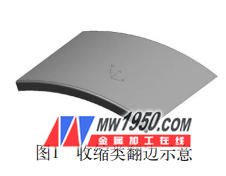Common defects in automotive sheet metal stampings include stacking, necking, rebound, crushing, slip lines, trimming and burrs. Among them, the part stacking refers to the complicated design of the shape of the part or the unreasonable design of the stamping process, and the sheet material flows poorly when the part is formed, and is piled up locally. Part stacking can seriously affect part matching and appearance quality. 1. Parts open process gap For flanged parts, when the flange of the part is a shrink-type flange, the flange is prone to stacking, as shown in Figure 1. The commonly used measure is to open the process gap in the flanged stacking area under the premise of ensuring the flanged overlap width and the flanging strength in the product design stage. 2. Parts increase suction characteristics In the product design stage, various shapes of bosses or sags are added to the areas where the parts are prone to stacking. For example, some door inner panels have some beautifully shaped slabs in the four corner areas. This is because when the inner panel of the door is drawn and formed, the materials in two adjacent directions flow to the corner area, and the additional table can absorb the excess sheet. 3. Optimize part punching direction For small and medium-sized parts, the method of optimizing the punching direction can be adopted, so that the area where the product is prone to be stacked first contacts the sheet material, thereby controlling the flow of the sheet material and suppressing the occurrence of the stacking phenomenon. Figure 2a shows the original state of a part with a stacking problem in the circled area. Fig. 2b and Fig. 2c respectively indicate the original punching direction and the improved punching direction of the part. Comparing the two, it can be known that the improved punching direction is a vertical stacking area, which can suppress the material flow to the stacking area. The role. 4. Optimize process replenishment Parts that are formed by the drawing process are complemented by processes. Process replenishment refers to the portion of the punch that is added to compensate for the imbalance in contour and height of the part. Adding process replenishment can make the sheet flow more uniform when the part is formed. In the part where the parts are easy to be stacked, the material inflow can be controlled by raising the nearby process to reduce the stacking phenomenon. This is also an effective method for solving part defects commonly used in the process design stage. Figure 3 is a partial process replenishment of a part. The part indicated by the arrow is supplemented by the process, and the rest is the part. The black circle area of ​​the part has a complicated shape, and the sheet material flows poorly during forming, and the stacking material is serious. Therefore, the design of the stamping process raises the nearby process replenishment, thereby achieving the purpose of reducing the stacking. 5. Optimize the ribs The parts formed by the drawing process, the ribs of the crimping ring can effectively control the inflow of the sheet material, and the stacking phenomenon can be suppressed by reasonably arranging the position of the ribs, adjusting the rounded size of the ribs, and arranging the double ribs. .
Give your home the star treatment with a fibre optic star ceiling kit. Our star ceiling kits are complete sets, containing optical fiber bundles and a light generator - all you need to create your own starry ceiling. Just a single light source can provide enough light for the perfect star ceiling. If you wanna customized it,please do not hesitate to contact with me.
Optical fiber,star ceiling,Fiber Optic Panel,Fiber Optic Tiles Jiangxi Daishing POF Co.,Ltd , https://www.jxopticfibrelight.com

Common solutions for the problem of car blanking and stacking
